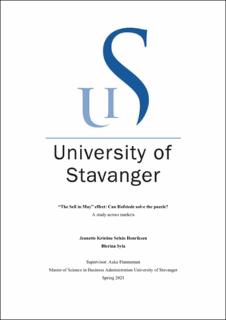| dc.contributor.advisor | Hunneman, Auke | |
| dc.contributor.author | Henriksen Selsås, Jeanette Kristine | |
| dc.contributor.author | Syla, Blerina | |
| dc.date.accessioned | 2021-09-08T16:27:07Z | |
| dc.date.available | 2021-09-08T16:27:07Z | |
| dc.date.issued | 2021 | |
| dc.identifier | no.uis:inspera:82490702:18047269 | |
| dc.identifier.uri | https://hdl.handle.net/11250/2774747 | |
| dc.description.abstract | The “Sell in May” effect has in previous research been referred to as a puzzle that remains to be solved. The persistence of the anomaly would pose a challenge to the notion of market efficiency and provide investors with an easy way to earn abnormal returns. With stock price data covering 99 different markets we analyze the presence of a statistically significant “Sell in May” effect in a total sample period from 1928 to 2020. Additionally, Hofstede's cultural dimensions are included in the analysis as an attempt to explain the phenomenon.
The time-series regressions provide evidence of a significant “Sell in May'' effect in 30 countries which is reduced to 27 when controlling for the January effect. The SIM effect is found to have a significant and positive impact on returns in both time-series regression and panel data regression. The results suggest a more pronounced SIM effect in developed markets and geographically in Europe and Asia. Panel data regression reveals that the regions South America and Europe contribute to explaining the phenomenon with significant and positive interaction effects. Additionally, the two cultural dimensions Indulgence and Long Term Orientation are found to explain the SIM effect and Hofstede has thus provided a piece of the puzzle. | |
| dc.description.abstract | | |
| dc.language | eng | |
| dc.publisher | uis | |
| dc.title | “The Sell in May” effect: Can Hofstede solve the puzzle? | |
| dc.type | Master thesis | |
